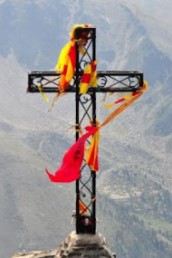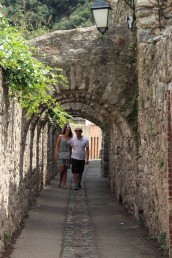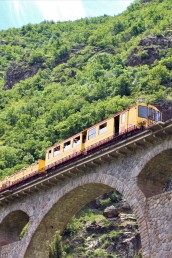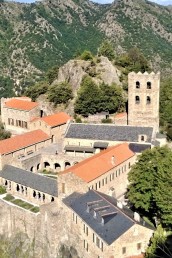CULTURE AND LANDSCAPES
Le Canigou
the sacred mountain of the Catalans
Wherever you are, wherever you come from, you will always hear a Catalan tell you about his Canigou. About its beauty when it is snowy, about its hiking trails that, in the middle of summer, will take you to the summit and its 2784m of altitude. Up there, all the way up, the cross is waiting for you.
And what about this panorama! Between the Mediterranean, the Pyrenees, Vallespir and Conflent. It is a magical, unforgettable moment for all Catalans who must one day climb this summit, but also for you, Friends Campers. You who will discover that this mountain is much more than just a mountain. It is sacred.
So on foot, on horseback, running, by bike or simply by 4×4, take on the Canigou or contemplate it! Great valleys, trails, forests, villages and old iron mines… the Massif du Canigou offers you exceptional scenery. And above all, don’t forget to take your time and look around you. A unique biodiversity awaits you: plants, flowers and mountain animals. A short hike, that tempts you? then follow the guide! A hike in the Canigou Massif

Villefranche-de-Conflent
the unavoidable city (6km)
Villefranche de Conflent, its history, its ramparts built by Vauban, its cobbled streets, its Yellow Train and its crafts.
It is not for nothing that it is often said that Villeranche-de-Conflent is the city of the Conflent, a small jewel of the Pyrénées-Orientales (66).
This old merchant city, capital of the Conflent has kept very beautiful traces of its past.
of its history. Today, three of its sites are listed as UNESCO World Heritage Sites. Walking on the side of Villefranche-de-Conflent, only 6.5km from the campsite Les portes du Canigou you will discover, the ramparts and the tower of the Viguerie, built by the count of Cerdagne in the 11th century, then reinforced by Vauban in the 17th century and the Fort Libéria,
recently inscribed on the UNESCO World Heritage List, or the stalls and houses of wealthy merchants, the Romanesque church of Saint-Jacques.
Another treasure of the city, the caves of the small and large Canalette which can be visited at the loing of the year for the delight of children.
Villefranche-de-Conflent is also the starting point of the Yellow Train. A symbol of the Catalan Country, which will take you, at its own pace, as far as Cerdanya.


The Yellow Train
A symbol in blood and gold (6 km)
Nicknamed “the Canary”, the Yellow Train is a symbol of the Catalan Country, which it proudly bears
the colours blood and gold.
In all seasons, it links Villefranche-de-Conflent to Latour-de-Carol.
Historically built to open up the Catalan high plateaux and offer the inhabitants an additional means of transport, the Yellow Train is today essentially a tourist train. A train that offers you a unique experience, an original way to discover the most beautiful landscapes of our territory.
Young and old alike, everyone enjoys this outing. From the technical prowess of the line to the multiple works to the discovery of the small Catalan villages of the valley…the whole family will be conquered by this timeless moment. Whether in a covered or open wagon, the sensations will be there.
QUELQUES CHIFFRES
- 62,8 km de voies et 390 courbes séparents Villefranche-de-Conflent à 427 m d'altitude de Latour-de-Carol, le terminus à 1231m.
- 650 ouvrages ont été édifiés dont 17 tunnels, 14 viaducs, 4 ponts voutés et 2 onts emblématiques : le Pont Séjourné et le Pont Giscard et ses 873 tonnes d'aciere. 22 gares virent le jour sur le tracé.
- Le Train Jaune c'est 400 000 passagers par an.

PRACTICAL INFORMATION
The Yellow Train runs all year round. Summer and winter timetables can be consulted here : Yellow Train timetables.
As the number of passengers is very high during the summer season, it is strongly advised to arrive at least 30 minutes before departure to buy your ticket and make sure you have a seat.
You can take the Yellow Train to get off at Mont-Louis and discover another work of fortification that is also due to Vauban.

Abbey, chapel and monastery
In love with old stones full of history, the Confent should satisfy all your desires. No other territory in the Pyrénées-Orientales will offer you so many monuments per km². From the abbey of Saint-Michel-de-Cuxa and its Romanesque cloister to the altarpiece of the church of Saint-Pierre de Prades, there is no shortage of visits.
But if we had to recommend one, it would be the abbey of Saint-Martin du Canigou, located 15km from the campsite. A place out of time. A place that can be discovered on foot, after a 40 minute walk or by 4×4 depending on the season. Situated in the heart of the Canigou Massif, on an eagle’s nest, the abbey discreetly overlooks the Cady valley. The Lombard bell tower, the marble capitals, the abbey church and the vaulted crypt make it a jewel of the first regional Romanesque art. The abbey is still inhabited by a community of nuns, the community of the Beatitudes.